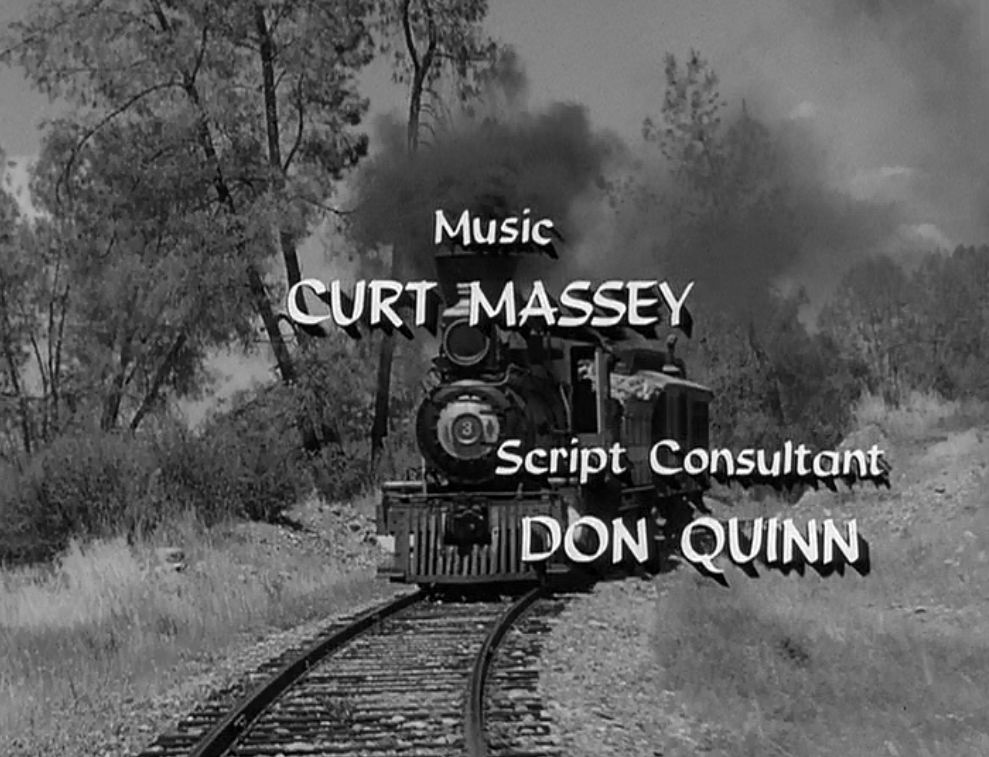Happy Birthday, Don Quinn!
The most fortuitous event that occurred in the life of writer-cartoonist Don Quinn—born in Grand Rapids, Michigan on this date in 1900—was meeting Jim Jordan at the studios of Chicago’s WENR. Jordan, an employee at the station along with his wife Marian, had heard that Quinn wrote jokes for a living and asked him to submit some material for a program on which he and Marian were performing, The Farmer Rusk Hour. Don received $10 for the jokes he concocted…which may not sound like much, but then again—there was a Depression on. Yet that sawbuck investment would reap handsome dividends when Quinn created for the couple one of old-time radio’s most beloved comedy shows: Fibber McGee & Molly.
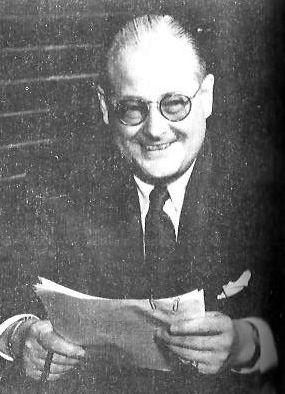 For a man who later made his living as a writer, Don Quinn’s formal schooling was brief—interrupted in tenth grade when he elected to put his studies on hiatus in order to serve in World War I. Later, Quinn would find work as a freelance cartoonist…but in an unusual twist, the magazines that he sold cartoons to would keep his captions while throwing out his artwork. His talent for gags attracted the notice of vaudeville duo Ole Olsen and Chic Johnson (after establishing himself in radio, Quinn later wrote for their Swift Revue program in 1933-34), who paid Don for his material as did other comics of that era. With the stock market crash of 1929, however, Quinn’s writing assignments started to dry up.
For a man who later made his living as a writer, Don Quinn’s formal schooling was brief—interrupted in tenth grade when he elected to put his studies on hiatus in order to serve in World War I. Later, Quinn would find work as a freelance cartoonist…but in an unusual twist, the magazines that he sold cartoons to would keep his captions while throwing out his artwork. His talent for gags attracted the notice of vaudeville duo Ole Olsen and Chic Johnson (after establishing himself in radio, Quinn later wrote for their Swift Revue program in 1933-34), who paid Don for his material as did other comics of that era. With the stock market crash of 1929, however, Quinn’s writing assignments started to dry up.
Don Quinn then decided to relocate to Chicago, the scene of a thriving radio community despite the fierce economic times. It wasn’t easy for Quinn, who later noted that the Windy City stations treated him “like a leper.” As such, his meeting Jim Jordan at WENR came just at the right time. Don was called upon to write scripts for The Smith Family, a comedy serial starring Jim and Marian, and was asked to revive an earlier series the couple had appeared on entitled Luke and Mirandy (when Jim and Marian moved to station WMAQ). On the new series — known as Smackout—The Crossroads of the Air — Jim played Luke Gray, an elderly codger whose general store was always “smack out” of everything, with Marian playing a variety of female characters. The Jordans earned $200 a week for the daily quarter-hour, with which they paid Don $40. The trio got a bit of nationwide exposure when Smackout began airing on the national NBC network. Quinn would eventually churn out a total of 948 scripts for Smackout before it departed the airwaves on August 3, 1935.
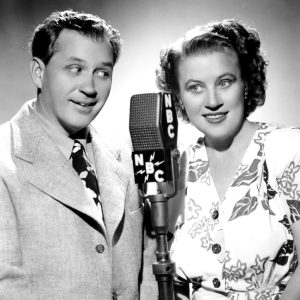 Some sources report that the wife of John Jeffry Louis—head of an advertising firm that had S.C. Johnson & Son as a client—was a fan of Smackout and recommended it to her husband when he was looking for a show for Johnson to sponsor. Others speculate that Louis himself was familiar with the show. Nevertheless, whoever was listening was clearly able to appreciate both the Jordans’ performing talent and Don Quinn’s genius for witty wordplay, resulting in an offer. Don was given $75 to write a sample script, and the Jordans would star in what eventually became The Johnson Wax Program with Fibber McGee & Molly, which premiered over NBC’s Red Network on April 16, 1935. In the early years of the program, Fibber and Molly McGee pursued a nomadic life of driving the highways and by-ways of this great country (thanks to the sponsor’s insistence that they promote their product “Carnu”). With the end of summer, Johnson’s insisted that the McGees switch to hawking “Glo-Coat”…so with the purchase of a winning raffle ticket, the couple put down stakes at radio’s most famous address: 79 Wistful Vista.
Some sources report that the wife of John Jeffry Louis—head of an advertising firm that had S.C. Johnson & Son as a client—was a fan of Smackout and recommended it to her husband when he was looking for a show for Johnson to sponsor. Others speculate that Louis himself was familiar with the show. Nevertheless, whoever was listening was clearly able to appreciate both the Jordans’ performing talent and Don Quinn’s genius for witty wordplay, resulting in an offer. Don was given $75 to write a sample script, and the Jordans would star in what eventually became The Johnson Wax Program with Fibber McGee & Molly, which premiered over NBC’s Red Network on April 16, 1935. In the early years of the program, Fibber and Molly McGee pursued a nomadic life of driving the highways and by-ways of this great country (thanks to the sponsor’s insistence that they promote their product “Carnu”). With the end of summer, Johnson’s insisted that the McGees switch to hawking “Glo-Coat”…so with the purchase of a winning raffle ticket, the couple put down stakes at radio’s most famous address: 79 Wistful Vista.
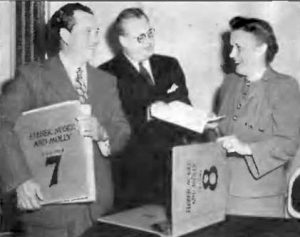 On the surface, Fibber McGee & Molly didn’t seem too remarkable a situation comedy (and indeed, some argue it isn’t due to its vaudeville skit-like nature): a husband with a propensity for tall tales (hence the nickname “Fibber”) engaged in constant domestic misadventures with his all-too-patient wife. But Don Quinn made Fibber & Molly an indisputable comedy classic. His playful way with words (“As the fat lady said as she took off her corset–that lets me out”) and skillful propensity with running gags (Fibber McGee’s famous hall closet is well-known even to those people who’ve never listened to a broadcast) kept audiences coming back week after week. In fact, it was often the number-one rated show during the 1940s (the WW2 years were unquestionably the series’ peak when it came to ratings). For the most part, Quinn was a one-man writing team, though he did have the occasional assistant in Winsor “Win” Anderson and future Beverly Hillbillies creator Paul Henning. Don wrote in marathon sessions, locking his door and arming himself with sandwiches, a pot of coffee, and two cartons of cigarettes. (Henning once observed in an interview that he tried to emulate Quinn’s method of writing and it nearly killed him.)
On the surface, Fibber McGee & Molly didn’t seem too remarkable a situation comedy (and indeed, some argue it isn’t due to its vaudeville skit-like nature): a husband with a propensity for tall tales (hence the nickname “Fibber”) engaged in constant domestic misadventures with his all-too-patient wife. But Don Quinn made Fibber & Molly an indisputable comedy classic. His playful way with words (“As the fat lady said as she took off her corset–that lets me out”) and skillful propensity with running gags (Fibber McGee’s famous hall closet is well-known even to those people who’ve never listened to a broadcast) kept audiences coming back week after week. In fact, it was often the number-one rated show during the 1940s (the WW2 years were unquestionably the series’ peak when it came to ratings). For the most part, Quinn was a one-man writing team, though he did have the occasional assistant in Winsor “Win” Anderson and future Beverly Hillbillies creator Paul Henning. Don wrote in marathon sessions, locking his door and arming himself with sandwiches, a pot of coffee, and two cartons of cigarettes. (Henning once observed in an interview that he tried to emulate Quinn’s method of writing and it nearly killed him.)
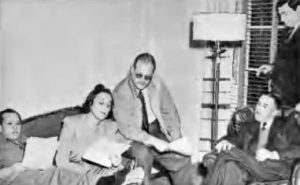 In 1943, Don Quinn started to cede some of his Fibber McGee & Molly writing duties to his protégé Phil Leslie, who would also take over as head writer on a series created by Quinn (featuring a character that had first appeared on Fibber & Molly), The Marlin Hurt and Beulah Show. Because Don had been the sole writer of the Jordans’ program for so many years, he received a heftier paycheck than most radio scribes (as a full partner, he split $6,000 a week three ways with Jim and Marian). When the Jordans sold the rights to their show to NBC (to stave off any “talent raid” from rival CBS), Quinn was included in the package, signing a seven-year exclusive deal with the network. At the peak of his career, Don Quinn was pulling down $3,000 a week for Fibber McGee & Molly, but in the fall of 1949, he announced he’d be leaving the show to pursue other projects.
In 1943, Don Quinn started to cede some of his Fibber McGee & Molly writing duties to his protégé Phil Leslie, who would also take over as head writer on a series created by Quinn (featuring a character that had first appeared on Fibber & Molly), The Marlin Hurt and Beulah Show. Because Don had been the sole writer of the Jordans’ program for so many years, he received a heftier paycheck than most radio scribes (as a full partner, he split $6,000 a week three ways with Jim and Marian). When the Jordans sold the rights to their show to NBC (to stave off any “talent raid” from rival CBS), Quinn was included in the package, signing a seven-year exclusive deal with the network. At the peak of his career, Don Quinn was pulling down $3,000 a week for Fibber McGee & Molly, but in the fall of 1949, he announced he’d be leaving the show to pursue other projects.
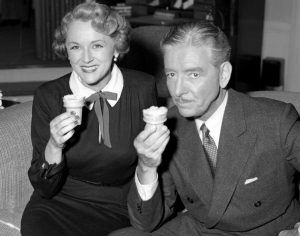 That project wound up being The Halls of Ivy, a comedy-drama about the administrator at a small-town college and his wife. It had originally starred Gale Gordon (a longtime Fibber McGee & Molly cast member) and Edna Best in a June 22, 1949 audition…but by the time it had its official premiere over NBC Radio on January 6, 1950, Ronald Colman and wife Benita Hume were portraying Dr. William Todhunter Hall and his wife Victoria. (The Colmans were likely considered good candidates thanks to their exposure on The Jack Benny Program.) The Peabody Award-winning series would air on radio until June 25, 1952 and later transition to TV (airing over CBS for a season in the fall of 1954). Quinn would look back fondly on the Ivy experience as one of the best of his life.
That project wound up being The Halls of Ivy, a comedy-drama about the administrator at a small-town college and his wife. It had originally starred Gale Gordon (a longtime Fibber McGee & Molly cast member) and Edna Best in a June 22, 1949 audition…but by the time it had its official premiere over NBC Radio on January 6, 1950, Ronald Colman and wife Benita Hume were portraying Dr. William Todhunter Hall and his wife Victoria. (The Colmans were likely considered good candidates thanks to their exposure on The Jack Benny Program.) The Peabody Award-winning series would air on radio until June 25, 1952 and later transition to TV (airing over CBS for a season in the fall of 1954). Quinn would look back fondly on the Ivy experience as one of the best of his life.
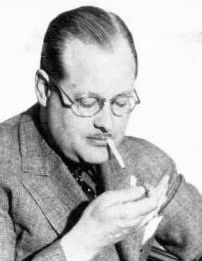 In 1953, Don Quinn accepted a position with Young & Rubicam to supervise comedy shows; he also worked as a story editor on the series Four Star Playhouse. Quinn’s stories were used on such series as Climax! (Don’s “Public Pigeon No. 1” would later be used for a Red Skelton film in 1957) and The Addams Family. In addition, he was briefly credited as a “script consultant” for his former assistant Paul Henning’s hit series Petticoat Junction. Toward his retirement years, Don ran a commercial production company (he didn’t care for that aspect of the business, complaining about the under-the-table deals and kickbacks) until his passing in 1967 at the age of 67.
In 1953, Don Quinn accepted a position with Young & Rubicam to supervise comedy shows; he also worked as a story editor on the series Four Star Playhouse. Quinn’s stories were used on such series as Climax! (Don’s “Public Pigeon No. 1” would later be used for a Red Skelton film in 1957) and The Addams Family. In addition, he was briefly credited as a “script consultant” for his former assistant Paul Henning’s hit series Petticoat Junction. Toward his retirement years, Don ran a commercial production company (he didn’t care for that aspect of the business, complaining about the under-the-table deals and kickbacks) until his passing in 1967 at the age of 67.
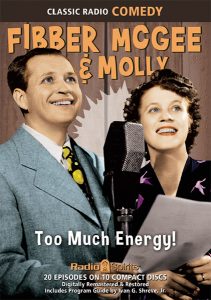 “Be fair in all things; don’t offend people; don’t hurt their feelings. Keep it clean—and keep it friendly—and it will keep you.” That was Don Quinn’s personal mantra throughout his life and career, and if Radio Spirits’ Fibber McGee & Molly collections are any indication…it certainly served him well. You can hear why our birthday boy is revered for his incredible skill at comedy writing in such sets as Cleaning the Closet (with liner notes from yours truly!), Gone Fishing, Too Much Energy, and Wistful Vista. There are also individual broadcasts of Quinn’s most famous radio contribution available on our potpourri aggregations of Comedy Goes West, Great Radio Comedy, and Radio Classics: Selected by Greg Bell; in addition, plenty of yuletide Fibber & Molly on Christmas Radio Classics, Radio’s Christmas Celebrations, and The Voices of Christmas Past. Finally, keep your eye out for the new The Halls of Ivy: School Days set, available later this month!
“Be fair in all things; don’t offend people; don’t hurt their feelings. Keep it clean—and keep it friendly—and it will keep you.” That was Don Quinn’s personal mantra throughout his life and career, and if Radio Spirits’ Fibber McGee & Molly collections are any indication…it certainly served him well. You can hear why our birthday boy is revered for his incredible skill at comedy writing in such sets as Cleaning the Closet (with liner notes from yours truly!), Gone Fishing, Too Much Energy, and Wistful Vista. There are also individual broadcasts of Quinn’s most famous radio contribution available on our potpourri aggregations of Comedy Goes West, Great Radio Comedy, and Radio Classics: Selected by Greg Bell; in addition, plenty of yuletide Fibber & Molly on Christmas Radio Classics, Radio’s Christmas Celebrations, and The Voices of Christmas Past. Finally, keep your eye out for the new The Halls of Ivy: School Days set, available later this month!

